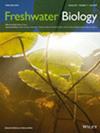Effects of Elevated Overwinter Temperature on the Growth Strategies of Microcystis aeruginosa
IF 2.8
2区 生物学
Q2 ECOLOGY
引用次数: 0
Abstract
- Overwintering is a crucial stage in the seasonal cycle of Microcystis, which is often overlooked as a state of “suspended animation”. With global warming and increasing heatwaves, temperature rise during the overwintering phase causes earlier recruitment or blooms. However, the impact of elevated overwinter temperatures on the growth of toxic Microcystis aeruginosa remains poorly understood.
- This study aimed to elucidate the physiological, metabolic and molecular mechanisms at different overwintering temperatures (4°C, 6°C, 4°C → 6°C → 8°C, 6°C → 8°C) by cellular growth, photosynthetic effect, metabolic products, enzyme activities and transcriptomic analysis.
- Elevated overwinter temperatures (4°C → 6°C → 8°C, 6°C → 8°C) significantly promoted the growth of M. aeruginosa. Photosynthetic activity responded rapidly, reaching its peak at the 9°C–16°C temperature range.
- Elevated overwinter temperatures also enhanced the secretion of microcystins and extracellular polymeric substances. These temperatures favoured the expression of rbcL and mcyB genes associated with photosynthetic and microcystin production, with significant activation of RuBisCO and FBA enzymes during recruitment. Furthermore, transcriptomic analysis revealed 321 genes with significant differential expression under elevated overwinter temperatures, including 156 up-regulated and 165 down-regulated genes.
- The interaction network highlighted proteins with the highest connectivity, comprising ribosomal proteins and RNA polymerase proteins, triggering processes related to oxidative phosphorylation and photosynthesis.
- This study sheds light on the intricate interplay of temperatures with the physiological and molecular dynamics of M. aeruginosa during overwintering, offering valuable insights into the effects of global warming on algae growth in the future.
越冬温度升高对铜绿微囊藻生长策略的影响
越冬是微囊藻季节循环的关键阶段,常被忽视为一种“假死”状态。随着全球变暖和越来越多的热浪,越冬阶段的温度升高会导致更早的繁殖或开花。然而,越冬温度升高对有毒铜绿微囊藻生长的影响仍然知之甚少。本研究旨在通过细胞生长、光合作用、代谢产物、酶活性和转录组学分析,阐明不同越冬温度(4°C、6°C、4°C→6°C→8°C、6°C→8°C)下的生理代谢和分子机制。越冬温度升高(4℃→6℃→8℃,6℃→8℃)显著促进了铜绿假单胞菌的生长。光合活性响应迅速,在9°C - 16°C温度范围内达到峰值。越冬温度的升高也促进了微囊藻毒素和细胞外聚合物质的分泌。这些温度有利于rbcL和mcyB基因的表达,这些基因与光合作用和微囊藻毒素的产生有关,在招募过程中RuBisCO和FBA酶被显著激活。转录组学分析显示,321个基因在越冬温度升高下表达差异显著,其中上调156个,下调165个。相互作用网络突出了具有最高连通性的蛋白质,包括核糖体蛋白和RNA聚合酶蛋白,触发与氧化磷酸化和光合作用相关的过程。这项研究揭示了温度与M. aeruginosa在越冬期间的生理和分子动力学之间复杂的相互作用,为未来全球变暖对藻类生长的影响提供了有价值的见解。
本文章由计算机程序翻译,如有差异,请以英文原文为准。
求助全文
约1分钟内获得全文
求助全文
来源期刊

Freshwater Biology
生物-海洋与淡水生物学
CiteScore
5.90
自引率
3.70%
发文量
162
审稿时长
2 months
期刊介绍:
Freshwater Biology publishes papers on all aspects of the ecology of inland waters, including rivers and lakes, ground waters, flood plains and other freshwater wetlands. We include studies of micro-organisms, algae, macrophytes, invertebrates, fish and other vertebrates, as well as those concerning whole systems and related physical and chemical aspects of the environment, provided that they have clear biological relevance.
Studies may focus at any level in the ecological hierarchy from physiological ecology and animal behaviour, through population dynamics and evolutionary genetics, to community interactions, biogeography and ecosystem functioning. They may also be at any scale: from microhabitat to landscape, and continental to global. Preference is given to research, whether meta-analytical, experimental, theoretical or descriptive, highlighting causal (ecological) mechanisms from which clearly stated hypotheses are derived. Manuscripts with an experimental or conceptual flavour are particularly welcome, as are those or which integrate laboratory and field work, and studies from less well researched areas of the world. Priority is given to submissions that are likely to interest a wide range of readers.
We encourage submission of papers well grounded in ecological theory that deal with issues related to the conservation and management of inland waters. Papers interpreting fundamental research in a way that makes clear its applied, strategic or socio-economic relevance are also welcome.
Review articles (FRESHWATER BIOLOGY REVIEWS) and discussion papers (OPINION) are also invited: these enable authors to publish high-quality material outside the constraints of standard research papers.
 求助内容:
求助内容: 应助结果提醒方式:
应助结果提醒方式:


